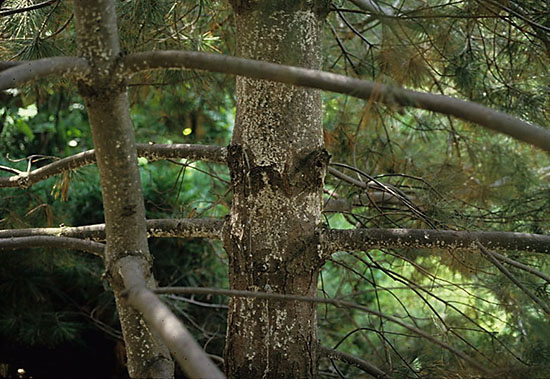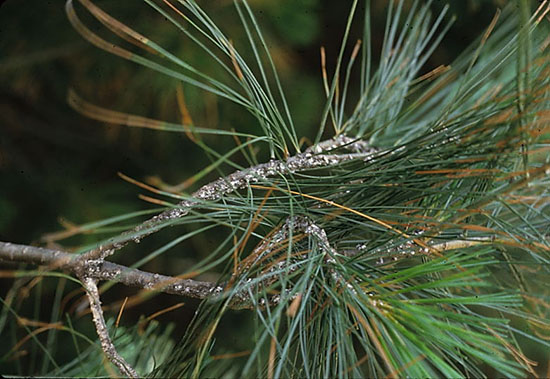Issue 13, August 25, 2014
Pine Bark Adelgid
Pine bark adelgid, also known as pine bark aphid, is common this year, particularly in western Illinois. It feeds primarily on the sap of twigs, branches, and trunk of Eastern white pine. It also attacks Scotch and Austrian pines as well as spruces. Very large infestations can kill trees.
Nymphs overwinter on the bark and mature into adults in the spring. Eggs hatch into crawlers that blow to other trees and plantings. They can alternate from pine to spruce, but they do not complete their life cycle on spruce. They normally have successive generations on pine.

Pine bark adelgids on white pine trunk.
Adelgids are closely related to aphids, feeding on plant sap with needle-like piercing-sucking mouthparts. Adelgids have very long mouthparts, allowing them to penetrate the wood beneath the bark on trunks of even mature pines. These one-eighth inch long, soft-bodied insects are covered with white, waxy strands, giving heavily-infested trees a flocked appearance.

Pine bark adelgids on white pine twigs.
Their feeding on plant sap results in their excretion of honeydew. Honeydew is essentially plant sap with most of the nitrogen and much of the water removed. This concentrated sap or light syrup-like honeydew is sticky and sugary. Black sooty mold grows on honeydew coated needles and bark. Unless there are obviously attacked trunks covered with the white insects, the black sooty mold covered needles and stems draw the scout's eye to discover pine bark adelgid. Because the insects contain large quantities of this honeydew as well, brushing your hand across an active infestation results in your hand being covered with gooey, sticky honeydew.
Pine bark adelgids tend to be most common in shaded areas such as the north and east sides of buildings where the relative humidity is higher. In woodlots, they are likely to be on the north and east edges where reduced sunlight and shading by understory edge trees and shrubs keep the relative humidity higher. Similarly, in sheared Christmas trees, one must part the foliage and scout the inner portions of branches and trunk to detect this pest. It is likely that the periodic rainfall and cooler weather conditions this summer have encouraged adelgid proliferation.
Pine bark adelgid is relatively easy to control once noticed and identified. Acephate (Orthene), acetamiprid (TriStar), malathion, and summer spray oil are effective. During the winter, dormant oil spray provides control. Timing is not critical as the insects are exposed and susceptible to insecticide sprays year-round. Dead pine bark adelgids have such long, needle-like mouthparts that they remain attached to the tree, so dead infestations appear like active ones. Control can be easily determined by brushing your hand across the infestation. Dead infestations will be dry and dusty instead of gooey and sticky. (Phil Nixon)
Author:
Phil Nixon